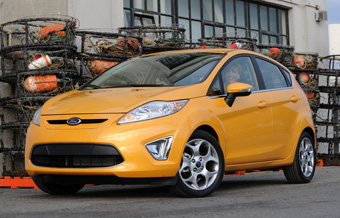
LAS VEGAS – Ford Motor Co.’s social-media guru uses a slightly modified Woody Allen quote to describe the auto maker’s approach to utilizing the platform to build sales and awareness of the brand.
“Ninety percent of social media is just showing up,” Scott Monty, Ford’s communications manager of global digital and multimedia, says at the Driving Sales Executive Summit here.
“You have to be where people expect you to be,” he says, noting Ford’s longtime sponsorship of the “American Idol” television show. “We have relevance because (consumers) know we are where they expect us to be.”
Monty, along with Ford’s chief marketer, Jim Farley, are considered the architects behind the largely successful Fiesta Movement, a marketing campaign that put 100 Fiestas in the hands of social-media users and asked them to post their comments and videos of their driving experience online.
The campaign, launched months before the ’11 Fiesta B-car hit dealerships, resulted in 58% consumer awareness of the product, a level some vehicles don’t reach even after several years on the market, according to Ford research.
The 58% awareness level came from unprecedented social-media exposure, Monty says, noting the Fiesta Movement generated more than 40 million Twitter impressions and 132,000 hits on the campaign’s website requesting more information.
The secret to the success of the Fiesta Movement was building trust among consumers, Monty says. “People don’t trust what companies have to say anymore.”
Special Coverage
 2010 Driving Sales Executive Summit
2010 Driving Sales Executive Summit
To build trust, Ford strives to forge a personal bond with consumers by responding to “tweets” through the social-media Twitter site and creating advertisements that feature Ford engineers, marketers and other employees.
People “appreciate that extra step to feel like they’re a part of something bigger than them,” he says. “They also appreciate authenticity. They can see a line of BS a mile away.”

To this end, Ford allowed consumers to post their thoughts and comments on the Fiesta website without censorship, which showed a great amount of trust. Consumers are bombarded with “thousands of brand messages every day,” Monty says. “So we’re vying hard for trust.”
The question then becomes what to do with that trust. Keeping the dialogue open and personal are key, but so is providing information consumers want and need about a vehicle without forcing it on them.
If you help consumers, as Ford strives to do through its social-media activities, they in turn will seek to help you, Monty says.
In the social-media realm, one consumer with a strong online presence can promote the auto maker’s message and brand, creating awareness among those who might not have considered buying a Ford, he notes.
Having the company’s message go viral, as it did with the Fiesta Movement, also can do away with preconceived notions of its brand. “We’re neck and neck with the best, but there’s a perception gap,” Monty says. “We’re using trust and people’s attention to help us (narrow that gap).”
Ford recently followed the Fiesta Movement with a Facebook reveal of its new ’11 Explorer SUV, which generated so much Web traffic that it crashed servers.
The Explorer online reveal was successful, Monty says, noting it was the No.1 trending topic on Twitter, No.2 in Google trends and generated more than 500,000 hits on Ford’s official Explorer website.
Although the auto maker’s social-media activities have been managed on a corporate level, Monty tells dealers here they can follow the same formula of personally engaging with their customers and being consistent in their message.
“You can’t take the same old mentality and apply it to the new world,” he says. “People pay attention when they feel like they’re getting what they need vs. the old style of getting it forced upon them. A personal touch evokes loyalty.”




